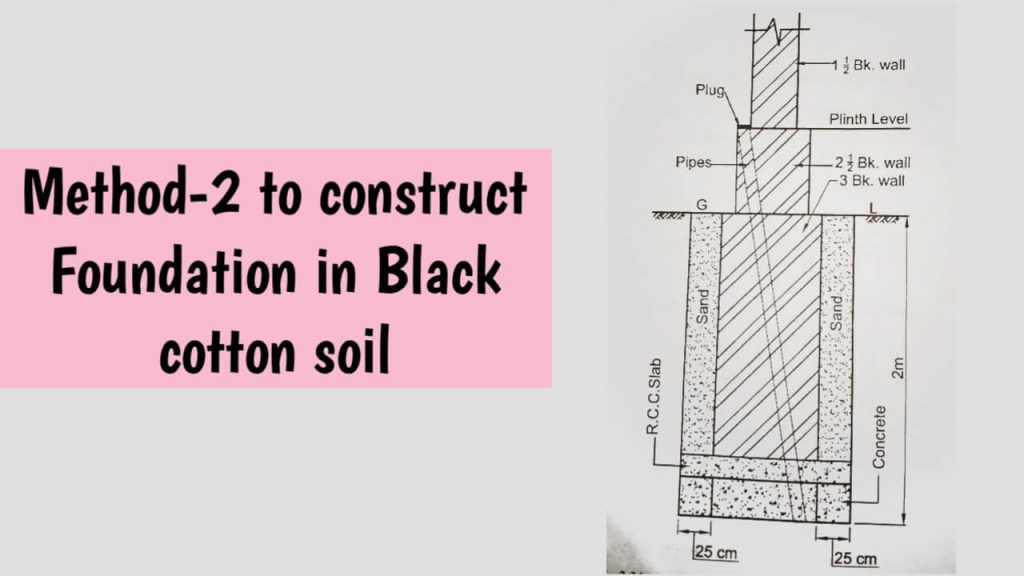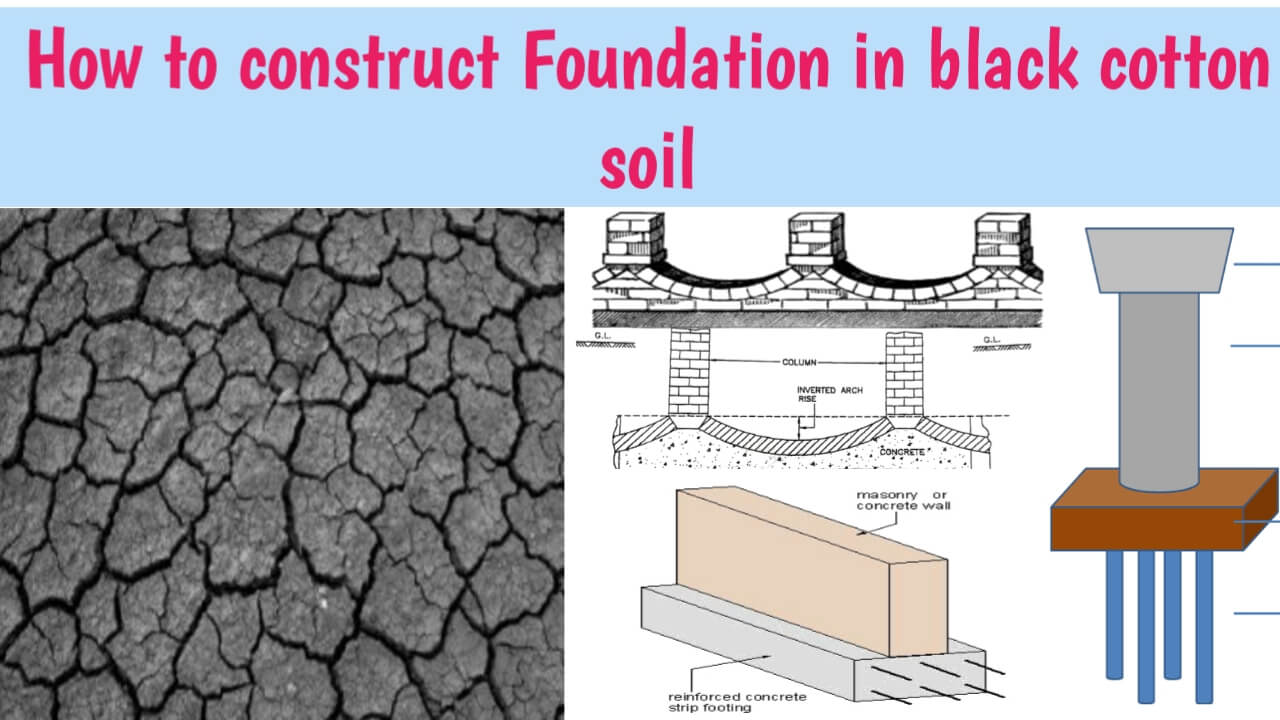Construction of foundation in black cotton soil is very risky due to its swelling and shrinkage property as well as its bearing capacity is also very less. Black cotton soil does not take a higher load. It is required soil stabilization for improving its property or well process for construction of the foundation.
In this article we explained which type of foundation used in black cotton soil and how to construct foundation in black cotton soil and so more.
First we understand what is black cotton soil? Why have risk to construction foundation in black cotton soil?
Table of Contents
What is Black cotton soil?
Black cotton soil is defined as soil that consists of swelling and shrinkage property. In a rainy season, it swells wherein a summer it shrinks. Black cotton soil is also called regur soil.
The name of this soil is formed from its physical property like most of the time its color is black and it is more suitable for cotton farming. That’s why its name formed black cotton soil.
Now the question is come,
Why black cotton soil is not suitable for foundation?
As per the definition, the black cotton soil consists of swell and shrink property. Due to shrinkage and swelling, a change in the volume of soil occur which develops cracks in the foundation or in the building structure.
The cracks is decrease the durability of structure. And most of cases the failure of structure occurs due to cracks.
And also the load bearing capacity of black cotton soil is very less which is causing various types of foundation failure like punching failure, general shear failure etc.
That’s why the construction of a foundation in black cotton soil is very risky.
Foundation in Black cotton soil:
When black soil is moist, its size increases, and its bearing capacity decreases. But when it is dry its size shrinks and the holding capacity improves. The change in size is 20 to 30%. Expansion or contraction in size causes cracks in the black soil.
These cracks are 10 cm to 15 cm wide and 2.5 m to 4.0 m deep. Black soil is excellent for farming but it is problematic for the formation of the foundation of the structure.
Points to be kept in mind while preparing foundation on black cotton soil:
The following precautions should be taken while preparing foundation in black cotton soil:
- Raft foundation should be made for important structures.
- Black soil should be completely removed if possible.
- Black clay should not come into direct contact with the foundation masonry. For this, gravel should be filled under the base and sand on the sides.
- Construction should be done in the dry season.
- The depth of the foundation should be 30 cm greater than the depth of the cracks in the black soil.
- All major walls should be filled with R.C.C coping at a plinth level or lintel level.
Also Read: What is Geosynthetic | Types of Geosynthetics
Which type of foundation is used in black cotton soil?
There are five major types of foundation used in black cotton soil.
- Strip footing or wall footing.
- Inverted arch footing.
- Mat foundation.
- Under reamed pile.
- Pier foundation.
1. Strip footing or wall footing:

Strip footing is one type of shallow foundation. Which is majorly used in past times for load-bearing structures.
For strip footing construction in black cotton soil, the black soil is removed or replaced with sand. The gravel is placed at the bottom of the foundation. Over it, the footing is constructed. Then sand is placed at the side of these pits.
Also read: Details of wall or strip footing
2. Inverted arch footing:
It is also one type of shallow foundation. An inverted arch is built between two pillars.
The lateral pier should be designed to withstand the pressure externally due to arch action. The inverted arch reduces the depth of the base. So this foundation is economical in soft soil.
This method is less used in the foundations of buildings. But more suitable for bridges, tanks, drainage line supports etc.
The inverted arch footing is more suitable for soft soil.
Also Read: Full details of Inverted Arch Footing
3. Mat foundation:

This also one type of shallow foundation. This types of shallow foundation, filling RCC slab over the entire construction area or some part of it. Many columns, walls are supported on this slab.
Mat foundation is more suitable for black cotton soil.
Also read: Different uses of Raft or mat foundation.
4. Under reamed pile.

Piles are type of deep foundation. Under reamed piles are specially design for black cotton soil. Under reamed piles consist bulb, based on its types defined.
Black cotton soil swells when in contact with moisture and shrinks when it dry. An under reamed piles are used in the foundation to remove these defects.
Also Read: What is Under reamed piles with construction procedure
Methods of construction of foundation in black cotton soil:
There are two methods of construction of foundation in black cotton soil.
Method 1:
When The depth of the black cotton soil is high and water from the surface is not likely to enter the soil to a depth of more than 1.5 m.

Method of construction of foundation in black cotton soil:
- Foundation trenches are dug 30cm deeper than the maximum depth of cracks.
- The width of the trench is kept so that the allowable bearing capacity of soil does not exceeds 15t/m2 i.e. the load should not exceed 15 t/m2.
- Gravel bed is placed into the trench and compact it.
- Then A 50 cm layer of concrete is laid over the gravel.
- Then masonry work on concrete is carried to the plinth level.
- The side of the masonry is filled with sand.
Method 2:
Black cotton soil with heavy rainfall and where surface water is more likely to penetrate deeper.

- The foundation trenches are dug up to 2m.
- Then The excavation is leveled and hardened.
- Two strips of concrete are prepared in a 25 cm x 25 cm cross-section on both sides in the trench.
- Sand is filled between these two strips.
- A layer of 10 cm to 15 cm thickness of RCC is laid on it.
- Then Masonry is done above the level of RCC. Which is carried up to the plinth. Both sides of the masonry are filled with sand.
- Pipes of 80 cm diameter are passed through masonry and slabs of RCC at a distance of 1.50 m c/c. The head of the pipe is kept at the plinth level and sand is filled in it. Plug is placed at the head of the pipe.
- The pipe is inspected twice a year and additional sand is added if required.
5. Pier Foundation:

The figure shows a pier foundation for a heavy bearing wall. The pier is dug at regular intervals and filled with cement concrete. Such a pear should be supported on a hard clay layer.
An arch is made in the upper part of the ground. The space between the arch and the ground is required for soil swelling and shrinkage.
Also Read:
- What is pile foundation || Types of pile foundation based on function, use, material
- 5 Method To Repair Brick Wall Defects || Repair of Brick Wall Cracks etc.

I am a Professional Civil & Structural Engineer having more than 4 years of experience in Engineering, Procurement and Construction industry. Here i sharing the latest updates of EPC Projects and Construction News.

